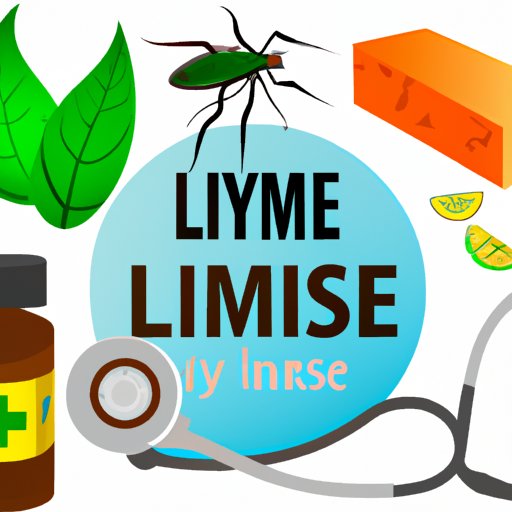
Introduction:
Lyme disease is a serious bacterial infection spread by ticks that can cause severe complications if not treated early. Proper treatment of Lyme disease is crucial to prevent long-term health issues such as heart and nerve problems. The purpose of this article is to provide information on various treatments, natural remedies, and the latest medical breakthroughs in Lyme disease. We will also share personal stories about Lyme disease to help readers understand how it can affect individuals and their families. Lastly, this article aims to educate the public on tick bite prevention and what to do if bitten.
Understanding Lyme Disease:
Lyme disease is an infection caused by the bacteria Borrelia burgdorferi. Ticks carry this bacteria and can transmit it while feeding on the host’s blood. Initial symptoms include a rash around the bite area, fever, and muscle aches. Without treatment, the disease can spread to other parts of the body, causing more severe symptoms such as joint pain, heart palpitations, and facial paralysis.
Accurate diagnosis of Lyme disease can be challenging because symptoms can mimic other illnesses. A blood test is usually used to confirm the diagnosis, but it may not detect the infection in the early stages. Therefore, seeking medical attention as soon as possible is critical.
Lyme disease has three stages, each with different symptoms. The first stage is an early localized infection where the rash occurs. The second stage is characterized by flu-like symptoms such as fatigue, fever, and swollen lymph nodes. The third stage occurs when the bacteria have spread to other parts of the body, causing severe and debilitating symptoms.
Personal Journey with Lyme Disease:
The experience with Lyme disease varies from person to person. Some people can be infected by ticks but never develop any symptoms, while others may face severe and long-lasting symptoms. Here we recount the story of a woman who contracted Lyme disease while hiking.
After experiencing flu-like symptoms, skin rashes, and joint pain, she sought medical attention and was diagnosed with Lyme disease. The treatment started with antibiotics, which she continued for a couple of months. However, the antibiotics seemed to cause more harm than good as they caused her stomach issues, low energy, and other side effects.
She then turned to alternative remedies such as herbal supplements and acupuncture. The herbal supplements seemed to provide relief and were less harmful than antibiotics. She also found that acupuncture helped her body cope with the pain and fatigue that accompanies Lyme disease.
In the end, she found that a combination of herbal supplements, acupuncture, and a healthy diet facilitated her healing process and provided tremendous relief. Although everyone’s experience with Lyme disease is different, it’s essential to explore different treatments to find what works best for the individual.
Alternative Treatments for Lyme Disease:
Despite antibiotics being the most common form of treatment for Lyme disease, some individuals prefer natural remedies. Popular natural remedies include herbal supplements such as Japanese Knotweed, Andrographis, and Garlic. These herbs reduce inflammation, support the immune system, and have antibiotic properties.
Acupuncture is another alternative treatment that aims to promote healing and restore balance and energy to the body. Usually, acupuncture is used to relieve pain, improve circulation, and boost the immune system.
Alternative remedies may have fewer side effects than traditional treatments, but they may not work for everyone. It’s best to consult with a healthcare provider before starting any alternative treatments to avoid any potential complications.
Latest Medical Research and Breakthroughs:
Researchers continue to study Lyme disease to better understand the bacteria and improve treatment options. Some promising treatments include immunotherapy, which leverages the immune system to directly attack the bacteria. Additionally, researchers are working on Lyme disease vaccines, which would prevent the disease from spreading to humans.
Researchers are also testing new antibiotics and drug combinations to improve treatment outcomes. Scientists are currently studying disulfiram, a drug used to treat alcohol dependence, for use in treating Lyme disease. It’s essential to keep up with scientific developments to determine the best course of treatment for Lyme disease.
Importance of Educating the Public:
The best way to prevent Lyme disease is by avoiding exposure to ticks. It’s important to wear protective clothing, use insect repellent, and check for ticks after spending time outside. If you find a tick on your skin, it’s essential to remove it promptly and monitor the site for any changes. Avoid squeezing or twisting the tick, and use needle-nose tweezers to grasp and pull it straight out.
Education is essential to raise awareness about the signs and symptoms of Lyme disease and promote preventative measures. By sharing personal stories and information about treatments and breakthroughs, we can help educate the public about the importance of Lyme disease prevention and prompt diagnosis.
Conclusion:
Lyme disease is a complicated and potentially chronic condition that requires early detection and proper treatment. A combination of antibiotics, alternative remedies, and promising medical breakthroughs can help provide relief and facilitate the healing process. By educating ourselves and the public on Lyme disease prevention and treatments, we can better manage and potentially eradicate the disease.





